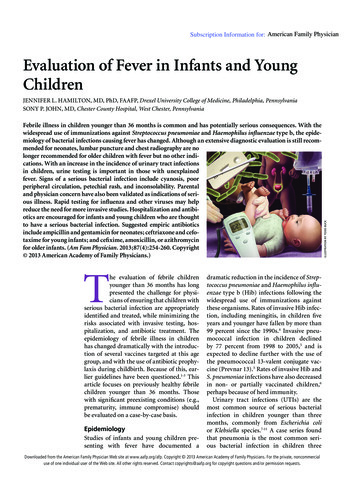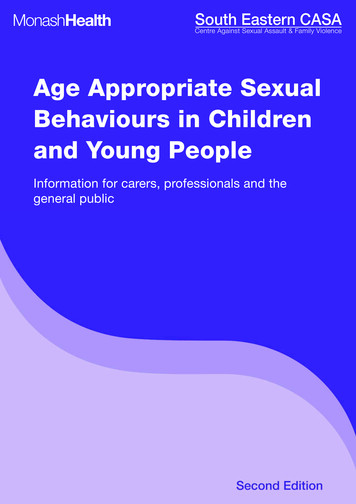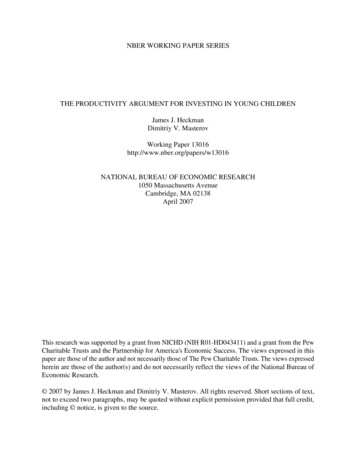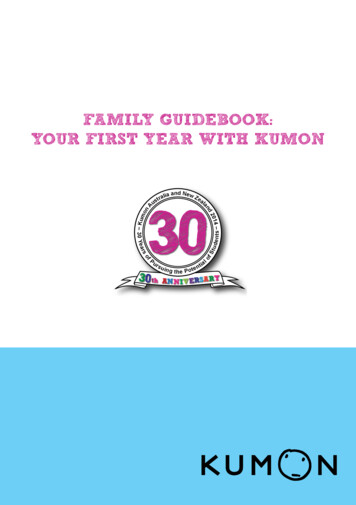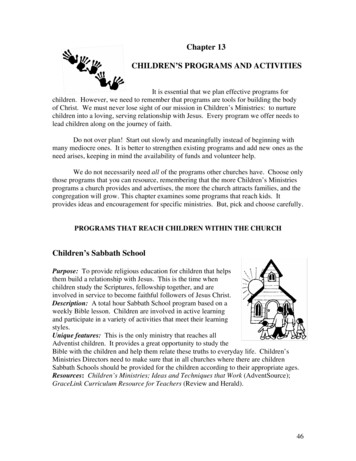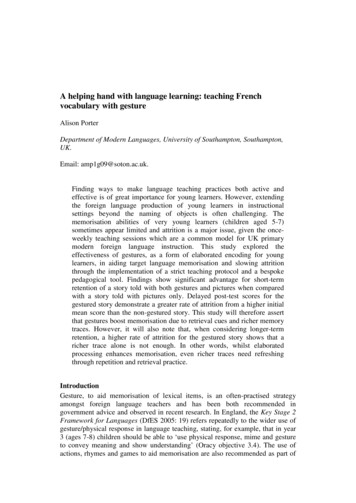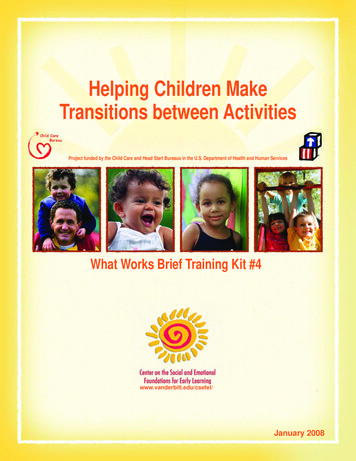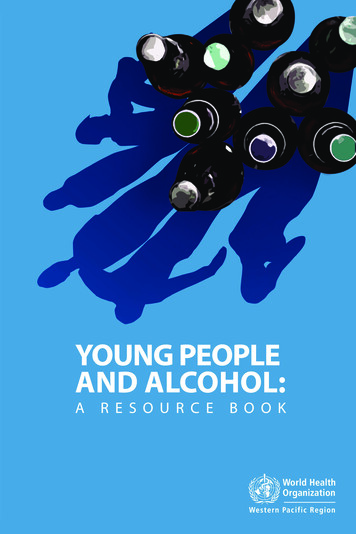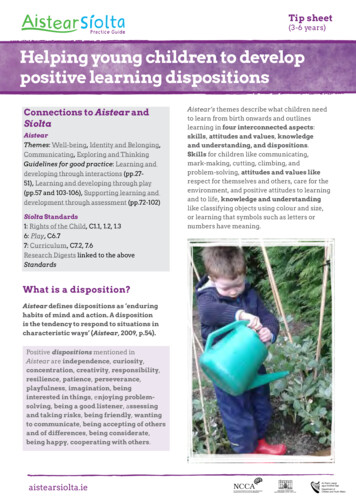
Transcription
Tip sheet(3-6 years)Helping young children to developpositive learning dispositionsConnections to Aistear andSíoltaAistearThemes: Well-being, Identity and Belonging,Communicating, Exploring and ThinkingGuidelines for good practice: Learning anddeveloping through interactions (pp.27-51), Learning and developing through play(pp.57 and 103-106), Supporting learning anddevelopment through assessment (pp.72-102)Síolta Standards1: Rights of the Child, C1.1, 1.2, 1.36: Play, C6.77: Curriculum, C7.2, 7.6Research Digests linked to the aboveStandardsWhat is a disposition?Aistear defines dispositions as ‘enduringhabits of mind and action. A dispositionis the tendency to respond to situations incharacteristic ways’ (Aistear, 2009, p.54).Positive dispositions mentioned inAistear are independence, curiosity,concentration, creativity, responsibility,resilience, patience, perseverance,playfulness, imagination, beinginterested in things, enjoying problemsolving, being a good listener, assessingand taking risks, being friendly, wantingto communicate, being accepting of othersand of differences, being considerate,being happy, cooperating with others.aistearsiolta.ieAistear’s themes describe what children needto learn from birth onwards and outlineslearning in four interconnected aspects:skills, attitudes and values, knowledgeand understanding, and dispositions.Skills for children like communicating,mark-making, cutting, climbing, andproblem-solving, attitudes and values likerespect for themselves and others, care for theenvironment, and positive attitudes to learningand to life, knowledge and understandinglike classifying objects using colour and size,or learning that symbols such as letters ornumbers have meaning.
Tip sheet: Helping young children to develop positive learning dispositions2Aistear also describes children’s learningin terms of dispositions that childrenneed in order to achieve their full potential.Dispositions, such as curiosity, independence,resilience, and perseverance are oftendescribed as innate or natural character traitsthat children possess from birth. However,children’s inborn dispositions vary and itis important to remember that adult-childinteractions and relationships, and theexperiences children are exposed to can have animpact on the development of positive learningdispositions.Why are dispositionsimportant?Learning dispositions have an impact on achild’s overall ability to learn and progress.Dispositions develop alongside and inconjunction with children’s acquisition ofknowledge, skills, attitudes and understanding.For example, a group of children constructingwith wooden blocks are developing the physicalskills of grasping, placing and stacking, andlearning about shape and size, while at the sametime developing the positive disposition ofconcentration and rejoicing in their problemsolving skills as they build. They may belearning too that we do not always succeed thefirst time, that we may have to try again andagain as the blocks come tumbling down or asanother child runs by and collapses their tower,and this helps them to develop the dispositionsof patience, perseverance and resilience.aistearsiolta.ieDispositions can be positive or negative some dispositions are less helpful than othersfor children’s learning and development.Dispositions are not fixed and they can beencouraged and strengthened, or weakenedover time. Practitioners should try to reinforcepositive dispositions. For example, childrenwho are never given the opportunity to dressthemselves or to tidy up will tend to rely toomuch on the adult and can develop learnedhelplessness (a negative disposition). Byencouraging children to be responsible fortheir own belongings and by getting them tohelp sweep up or put things in the recycling,practitioners are helping them to developthe positive dispositions of independenceand self-reliance. If a child is naturallyanxious and wary of new situations or people,practitioners can encourage the child to bemore adventurous and flexible by introducingchanges gradually, explaining what will happenbefore change occurs and by giving lots ofreassurance.
Tip sheet: Helping young children to develop positive learning dispositions3Dispositions can be encouraged ordiscouraged, and strengthened orweakened, through experience andthrough interactions with others and theenvironment.How can I encourage positivedispositions?Learning dispositions have an impact on achild’s overall ability to learn and progress. Bybeing aware of the kind of dispositions that arehelpful, practitioners can plan for a supportiveenvironment and interactions that willencourage positive dispositions. For example, model the dispositionshow that you value the dispositionprovide opportunities for childrento develop dispositions (time, space,equipment or encouragement).take individual differences and preferencesinto account, for example by introducingchanges gradually, or by giving extrasupport to a child who needs it.More detail on how you might encouragethe development of positive dispositions isoutlined below.Encouraging independence andresilience: aistearsiolta.ieProvide an environment that enableschildren to be more independent accessible storage, picture labels onshelving and boxes, low sinks for handwashing, low-level coat and apron racks,and space for personal items.Provide children with tasks to developresponsibility e.g. helping set up activities,turning off lights, distributing drinks,tidying away the props, paints and toys etc.(independence)Allow children to choose activities andmake decisions (at an appropriate level)- Do you want to go inside now or stayoutside for a bit longer? (independence)Wait before you offer help, allow the childtime to find a solution, and if there is still adifficulty, ask the child Which part wouldyou like help with?Suggest strategies and model ways ofcoping with the inevitable failures anddisappointments in life in order to developresilience - both acknowledging children’sfeelings and perhaps suggesting analternative strategy:
Tip sheet: Helping young children to develop positive learning dispositions -- We were planning to have a picnictoday, but it’s much too wet. What do youthink we could do instead? Maybe wecould have our picnic inside today, andgo to the park tomorrow?With older children, it might be good to usedrama/role play/puppetry sometimes toencourage and model certain dispositions. Encourage concentration andperseverance: Show that you value the disposition, bynoticing and commenting on it. When achild has spent a long time focusing onsomething, or has finally managed tocomplete something you could say: I sawyou working hard on that- it looks greatnow!Encourage children to problem-solve forthemselves:-- We don’t have enough cups for everyone,what shall we do?-- How can we get the water wheel to turn?Provide encouragement to persevere andtry again, as needed:-- Nearly there – one more step and you’llbe at the top.-- Oh no, the ramp for the cars didn’t workagain, what else could we try?Give children space and time when theyare absorbed in a task or activity, and makesure they are not disturbed unnecessarilyby other children or by adults:-- Don’t disturb Sean and Lia just now, theyare concentrating really hard on gettingall those shapes into place.-- We will add a bit of time here so thatyou can finish making the constructionbefore we head back inside.Encourage curiosity and a willingnessto learn: Follow the child’s lead - notice what theyare interested in and respond to theirquestions.aistearsiolta.ie 4Provide a variety of opportunities toexperience and explore different objectsand environments, and talk about what youand the children see, feel, and do:-- Feel the bark on the cherry tree- it’smuch smoother and shinier than the oaktree, isn’t it?-- What’s making that noise, I wonder?Model curiosity, and a willingness tolearn: That’s an interesting bug you’vefound. I don’t know what it is. I haven’tseen one of those before. I wonder how wecould find out more about it?Encourage children to think of differentways that they might solve a problem,rather than immediately providing asolution:-- What could we find that would be longenough to bridge the gap? Where couldyou look for something like that? Whichfriend might be able to help?
Tip sheet: Helping young children to develop positive learning dispositions You might give clues rather than providingan immediate answer - I can see it fromhere, it’s near something blue, it’s not ontop of the table.Show that you are interested in lots ofdifferent things, and share your owninterests. For example, a love of gardening,baking, athletics or playing a musicalinstrument.Provide new and interesting activities overtime as well as familiar ones, or rotateactivities in one part of the setting whilekeeping children’s favourites (enjoyingnew things, enjoying exploring). See thesample learning opportunities in Aistear’sthemes for ideas.Encouraging creativity, collaborationand other dispositions Provide opportunities for the kind ofinteractions that will allow the child toput their dispositions like cooperation,collaborating with others, being socialinto action. Encourage children to cooperate, by giving lots of opportunities forinteractions with peers, and for working inpairs or small groups on tasks or projects:-- You and Lana really worked welltogether to build the house. Would youlike to sit together for snack?-- Have pair rotas for some jobs etc so thatchildren get to mix.Experiences like art, water and sand, andplay with open-ended and loose materialsaistearsiolta.ie 5like stones, twigs or shells, all encouragecreativity and imagination.Allow children to use materials indifferent and innovative ways, or tocombine different materials (creativity,imagination).Listening to stories and reading togetherencourages concentration, imagination,curiosity. Providing a quiet comfortablebook corner and sharing books withchildren encourages them to see books andreading as something to be enjoyed.
Tip sheet: Helping young children to develop positive learning dispositionsStrategies and interactions like these will helpchildren develop holistically, so that as theyacquire the skills and knowledge they need,they are also developing positive dispositionsthat will benefit them both now and in thefuture. It’s also important to explain theimportance of positive learning dispositions toparents and to encourage them to watch out forand support them at home.Assessing dispositionsAistear’s guidelines on Supporting learningand development through assessment (2009,pp72-102) discuss the importance of observingwhat children do, make and say over time,and using this information to plan for futureexperiences. The Guidelines (p. 74) suggestthat the adult should look for evidence of thechild’s progress across four interconnectedaspects as outlined above: skills, attitudesand values, knowledge and understandingand dispositions.Dispositions can be difficult to assess and itmay only become clear that a child possessesa certain disposition after getting to knowa child over a period of time. Observingchildren as they interact and play allows us tosee how they demonstrate their dispositionsand it is important to include dispositionsin assessment as positive dispositionsare being increasingly recognised asbeing crucial for children’s learning anddevelopment!aistearsiolta.ie6
Helping young children to develop positive learning dispositions Tip sheet (3-6 years) Aistear’s themes describe what children need to learn from birth onwards and outlines learning in four interconnect
